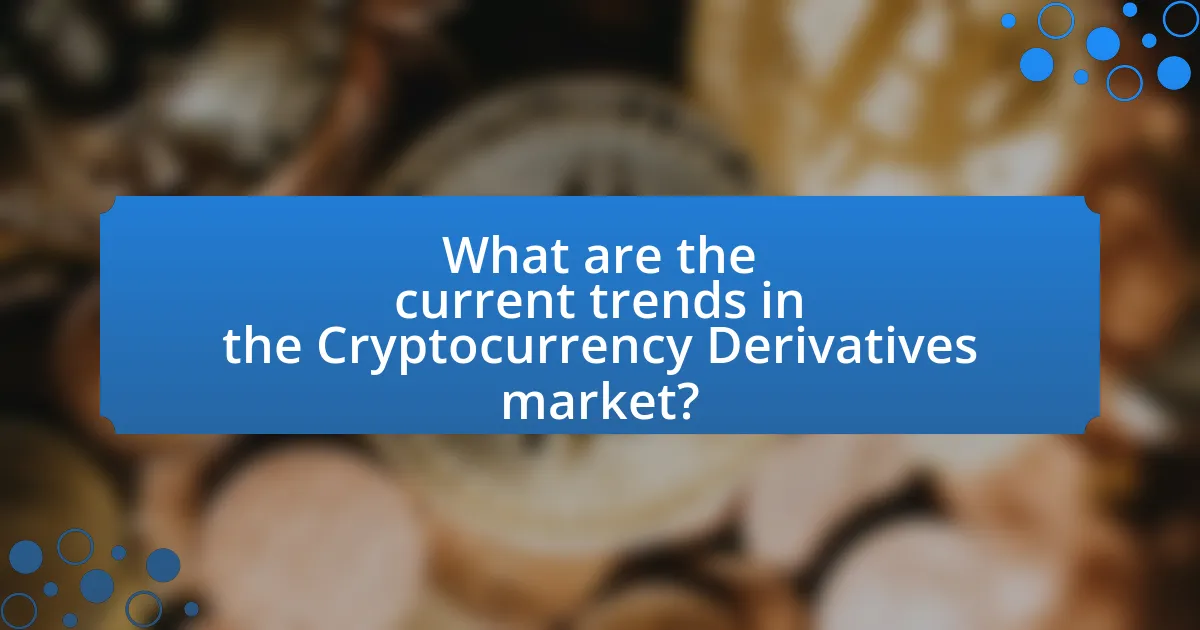The article focuses on the market analysis of cryptocurrency derivatives, which are financial contracts whose value is based on underlying cryptocurrencies. It explores the functioning of these derivatives, including types such as futures, options, and swaps, and highlights their importance for investors in terms of hedging and speculation. The article also examines current trends, including increased institutional participation and the rise of decentralized finance (DeFi) derivatives, while addressing the risks and rewards associated with trading these instruments. Additionally, it discusses the impact of regulatory changes, technological advancements, and strategies for maximizing returns in the evolving cryptocurrency derivatives market.

What are Cryptocurrency Derivatives?
Cryptocurrency derivatives are financial contracts whose value is derived from the price of underlying cryptocurrencies. These instruments include futures, options, and swaps, allowing traders to speculate on price movements or hedge against market volatility. The global cryptocurrency derivatives market has seen significant growth, with trading volumes reaching over $1 trillion in 2021, indicating a rising interest among investors and institutions. This growth is driven by the increasing adoption of cryptocurrencies and the demand for risk management tools in the volatile crypto market.
How do Cryptocurrency Derivatives function in the market?
Cryptocurrency derivatives function in the market by allowing traders to speculate on the future price movements of cryptocurrencies without owning the underlying assets. These financial instruments, such as futures and options, enable participants to hedge against price volatility or leverage their positions for potential profit. For instance, the Chicago Mercantile Exchange (CME) introduced Bitcoin futures in December 2017, which provided institutional investors with a regulated platform to trade Bitcoin derivatives, thereby increasing market liquidity and price discovery. This mechanism allows traders to enter contracts that obligate them to buy or sell a specific amount of cryptocurrency at a predetermined price on a future date, facilitating risk management and investment strategies in the rapidly evolving cryptocurrency landscape.
What types of Cryptocurrency Derivatives are available?
The types of cryptocurrency derivatives available include futures, options, swaps, and perpetual contracts. Futures contracts allow traders to buy or sell a specific amount of cryptocurrency at a predetermined price on a future date, while options give the holder the right, but not the obligation, to buy or sell at a specified price before a certain date. Swaps involve exchanging cash flows or returns based on the underlying cryptocurrency’s performance, and perpetual contracts are similar to futures but do not have an expiration date, allowing for continuous trading. These derivatives are utilized for hedging, speculation, and arbitrage in the cryptocurrency market.
How do these derivatives differ from traditional financial derivatives?
Cryptocurrency derivatives differ from traditional financial derivatives primarily in their underlying assets and market structure. Traditional derivatives are typically based on established assets like stocks, bonds, or commodities, while cryptocurrency derivatives are based on digital currencies such as Bitcoin or Ethereum. Additionally, cryptocurrency derivatives often exhibit higher volatility and leverage, allowing for greater potential returns but also increased risk. The market for cryptocurrency derivatives operates 24/7, contrasting with the limited trading hours of traditional markets, which can lead to rapid price fluctuations and unique trading strategies. This distinction is supported by the fact that the cryptocurrency market has seen significant growth, with the total market capitalization reaching over $2 trillion in 2021, highlighting the increasing relevance of these financial instruments.
Why are Cryptocurrency Derivatives important for investors?
Cryptocurrency derivatives are important for investors because they provide opportunities for hedging, speculation, and increased market liquidity. By allowing investors to bet on the future price movements of cryptocurrencies without owning the underlying assets, derivatives enable risk management strategies that can protect against market volatility. For instance, the global cryptocurrency derivatives market reached a trading volume of over $1 trillion in 2021, highlighting the significant interest and participation from investors seeking to capitalize on price fluctuations. This growing market not only enhances liquidity but also attracts institutional investors, further legitimizing the cryptocurrency ecosystem.
What risks and rewards do Cryptocurrency Derivatives present?
Cryptocurrency derivatives present significant risks and rewards. The primary reward is the potential for high returns due to leverage, allowing traders to control larger positions with a smaller amount of capital. For instance, a 10x leverage can amplify profits, making it attractive for speculative trading. However, the risks include high volatility, which can lead to substantial losses, especially when market conditions shift rapidly. According to a report by the Financial Stability Board, the derivatives market can exacerbate systemic risks due to interconnectedness and lack of transparency. Additionally, regulatory uncertainties can impact the market, leading to sudden price fluctuations. Thus, while cryptocurrency derivatives offer opportunities for profit, they also carry inherent risks that require careful management.
How do they enhance trading strategies for investors?
Cryptocurrency derivatives enhance trading strategies for investors by providing tools for risk management and speculation. These financial instruments, such as futures and options, allow investors to hedge against price volatility, enabling them to protect their portfolios from adverse market movements. For instance, a study by the Bank for International Settlements in 2021 highlighted that derivatives can reduce the impact of price fluctuations, thereby stabilizing returns. Additionally, derivatives facilitate leverage, allowing investors to control larger positions with a smaller amount of capital, which can amplify potential gains. This leverage aspect was evidenced by a report from CoinMarketCap, which noted that the trading volume of cryptocurrency derivatives surpassed spot trading volume in 2020, indicating their growing importance in trading strategies.

What are the current trends in the Cryptocurrency Derivatives market?
The current trends in the Cryptocurrency Derivatives market include increased institutional participation, the rise of decentralized finance (DeFi) derivatives, and the growing popularity of options trading. Institutional investors are increasingly entering the market, as evidenced by significant investments from firms like MicroStrategy and Tesla, which have contributed to a more mature market environment. Additionally, DeFi platforms such as Synthetix and dYdX are gaining traction, allowing users to trade derivatives without intermediaries, reflecting a shift towards decentralized trading solutions. Furthermore, options trading volume has surged, with platforms like Deribit reporting record highs, indicating a growing interest in hedging strategies and speculative trading among retail and institutional investors alike.
How has the demand for Cryptocurrency Derivatives changed recently?
The demand for cryptocurrency derivatives has significantly increased recently, driven by heightened market volatility and growing institutional interest. According to data from the Commodity Futures Trading Commission, the open interest in Bitcoin futures reached an all-time high in 2023, indicating a surge in trading activity. Additionally, platforms like Binance and CME Group reported record volumes in options and futures contracts, reflecting a broader acceptance of these financial instruments among both retail and institutional investors. This trend suggests that market participants are increasingly utilizing derivatives for hedging and speculative purposes, further solidifying their role in the cryptocurrency ecosystem.
What factors are driving the growth of Cryptocurrency Derivatives?
The growth of cryptocurrency derivatives is primarily driven by increased market participation and demand for risk management tools. As institutional investors enter the cryptocurrency space, they seek derivatives to hedge against volatility and manage exposure. Additionally, the rise of decentralized finance (DeFi) platforms has expanded access to derivatives, allowing more traders to engage in these financial instruments. According to a report by the Bank for International Settlements, the trading volume of cryptocurrency derivatives surged to over $1 trillion in 2021, highlighting the growing interest and adoption among market participants.
How do regulatory changes impact market trends?
Regulatory changes significantly impact market trends by altering the legal landscape in which businesses operate. For instance, when governments introduce stricter regulations on cryptocurrency derivatives, it can lead to decreased market participation due to increased compliance costs and risks. A notable example is the European Union’s Markets in Crypto-Assets Regulation (MiCA), which aims to create a unified regulatory framework for cryptocurrencies. This regulation can lead to increased investor confidence, potentially driving market growth, as seen in the rise of compliant platforms post-announcement. Conversely, regulatory crackdowns, such as those seen in China, can lead to market contractions, evidenced by the sharp decline in trading volumes and market capitalization following such announcements.
What technological advancements are influencing Cryptocurrency Derivatives?
Technological advancements such as blockchain scalability solutions, smart contracts, and decentralized finance (DeFi) platforms are significantly influencing cryptocurrency derivatives. Blockchain scalability solutions, like the Lightning Network and Ethereum 2.0, enhance transaction speeds and reduce costs, making derivatives trading more efficient. Smart contracts automate and enforce the terms of derivatives agreements, minimizing counterparty risk and increasing trust in transactions. Additionally, DeFi platforms provide innovative trading options and liquidity pools, allowing users to create and trade derivatives without traditional intermediaries. These advancements collectively contribute to a more robust and accessible cryptocurrency derivatives market.
How does blockchain technology enhance the trading of derivatives?
Blockchain technology enhances the trading of derivatives by providing increased transparency, security, and efficiency in transactions. The decentralized nature of blockchain allows for real-time settlement of trades, reducing counterparty risk and the need for intermediaries. This is evidenced by platforms like Ethereum, which enable smart contracts that automate and enforce the terms of derivative agreements, thereby minimizing disputes and enhancing trust among parties. Additionally, blockchain’s immutable ledger ensures that all transaction records are tamper-proof, further bolstering the integrity of the trading process.
What role do decentralized finance (DeFi) platforms play?
Decentralized finance (DeFi) platforms facilitate peer-to-peer financial transactions without intermediaries, enabling users to lend, borrow, trade, and earn interest on cryptocurrencies. These platforms utilize smart contracts on blockchain technology, which enhances transparency and reduces costs associated with traditional financial systems. According to a report by DeFi Pulse, the total value locked in DeFi reached over $80 billion in 2021, illustrating the significant adoption and impact of these platforms in the financial ecosystem.

What opportunities exist in the Cryptocurrency Derivatives market?
The Cryptocurrency Derivatives market presents opportunities such as hedging against price volatility, leveraging positions for increased returns, and accessing a broader range of investment strategies. These derivatives, including futures and options, allow traders to manage risk effectively; for instance, the global cryptocurrency derivatives trading volume reached approximately $1 trillion in 2021, indicating significant market participation. Additionally, the introduction of regulated platforms enhances investor confidence, further expanding market accessibility and participation.
How can investors capitalize on emerging trends?
Investors can capitalize on emerging trends by conducting thorough market research to identify new opportunities in cryptocurrency derivatives. By analyzing data on trading volumes, regulatory changes, and technological advancements, investors can make informed decisions that align with market shifts. For instance, the rise of decentralized finance (DeFi) has led to increased interest in derivatives linked to DeFi protocols, allowing investors to leverage these trends for potential profit. Historical data shows that early adopters of Bitcoin futures in 2017 saw significant returns, highlighting the importance of timely investment in emerging trends.
What strategies can be employed to maximize returns?
To maximize returns in cryptocurrency derivatives, investors can employ strategies such as leveraging, diversification, and utilizing options. Leveraging allows traders to amplify their exposure to price movements, potentially increasing returns; for instance, using 2x leverage can double profits if the market moves favorably. Diversification across various cryptocurrencies and derivatives can mitigate risks and enhance overall portfolio performance, as evidenced by studies showing that diversified portfolios tend to yield higher risk-adjusted returns. Additionally, utilizing options strategies, such as covered calls or protective puts, can provide income and downside protection, further maximizing potential returns.
Which market segments show the most potential for growth?
The market segments showing the most potential for growth in cryptocurrency derivatives include decentralized finance (DeFi) derivatives, options trading, and institutional investment products. DeFi derivatives have gained traction due to their ability to provide users with greater control and flexibility, with the total value locked in DeFi protocols exceeding $80 billion as of 2023. Options trading is expanding as traders seek to hedge risks and speculate on price movements, evidenced by a significant increase in open interest in cryptocurrency options, which reached over $10 billion in 2023. Additionally, institutional investment products, such as Bitcoin ETFs, are attracting substantial capital, with several funds reporting inflows exceeding $1 billion in the past year, indicating strong demand from institutional investors.
What challenges must be addressed to seize these opportunities?
To seize opportunities in the cryptocurrency derivatives market, regulatory uncertainty must be addressed. The lack of clear regulations creates risks for investors and institutions, hindering market growth. For instance, a report by the Financial Stability Board in 2020 highlighted that inconsistent regulatory frameworks across jurisdictions can lead to market fragmentation and increased compliance costs. Additionally, the volatility of cryptocurrencies poses a challenge, as significant price fluctuations can deter participation from traditional investors. According to a 2021 study by the Bank for International Settlements, high volatility in cryptocurrency markets can lead to substantial financial losses, making risk management essential for market participants. Lastly, technological challenges, including cybersecurity threats and the need for robust trading infrastructure, must be overcome to ensure market integrity and investor confidence.
How can investors mitigate risks associated with Cryptocurrency Derivatives?
Investors can mitigate risks associated with cryptocurrency derivatives by employing strategies such as diversification, using stop-loss orders, and conducting thorough market analysis. Diversification reduces exposure to any single asset, thereby lowering potential losses; for instance, spreading investments across various cryptocurrencies can buffer against volatility. Utilizing stop-loss orders allows investors to automatically sell derivatives at predetermined prices, limiting losses during market downturns. Additionally, conducting thorough market analysis, including understanding market trends and volatility patterns, equips investors with the knowledge to make informed decisions, thereby reducing the likelihood of significant financial loss. These strategies are supported by historical data showing that diversified portfolios tend to perform better in volatile markets, as evidenced by research from the CFA Institute, which highlights the importance of risk management in investment strategies.
What best practices should be followed in trading Cryptocurrency Derivatives?
To effectively trade cryptocurrency derivatives, traders should implement risk management strategies, conduct thorough market analysis, and stay informed about regulatory developments. Risk management involves setting stop-loss orders and position sizing to limit potential losses, which is crucial given the high volatility of cryptocurrencies. Conducting market analysis, including technical and fundamental analysis, helps traders make informed decisions based on price trends and market sentiment. Staying updated on regulatory changes is essential, as these can significantly impact market conditions and trading strategies. For instance, the introduction of regulations in various jurisdictions has historically influenced trading volumes and price movements in the cryptocurrency market.
What are the future prospects for Cryptocurrency Derivatives?
The future prospects for cryptocurrency derivatives are promising, driven by increasing institutional adoption and regulatory clarity. As of 2023, the global cryptocurrency derivatives market has seen significant growth, with trading volumes reaching over $1 trillion monthly, indicating strong demand. This growth is supported by the entry of traditional financial institutions into the crypto space, which enhances market legitimacy and liquidity. Additionally, advancements in technology, such as decentralized finance (DeFi) platforms, are expanding the range of derivative products available, catering to diverse investor needs. The ongoing development of regulatory frameworks in various jurisdictions is expected to further stabilize the market, attracting more participants and fostering innovation.
How might market dynamics evolve in the coming years?
Market dynamics in the cryptocurrency derivatives sector are likely to evolve towards increased institutional participation and regulatory clarity. As institutional investors continue to enter the market, evidenced by a 2021 report from Fidelity Digital Assets indicating that 70% of institutional investors are interested in digital assets, the demand for sophisticated derivatives products will rise. Additionally, regulatory frameworks are expected to become more defined, as seen in the European Union’s Markets in Crypto-Assets (MiCA) regulation, which aims to provide a comprehensive legal framework for cryptocurrencies and their derivatives. This regulatory clarity will likely enhance market stability and attract further investment, ultimately shaping the future landscape of cryptocurrency derivatives.
What innovations could reshape the Cryptocurrency Derivatives landscape?
Innovations such as decentralized finance (DeFi) protocols, automated market makers (AMMs), and the integration of artificial intelligence (AI) for predictive analytics could reshape the Cryptocurrency Derivatives landscape. DeFi protocols enable peer-to-peer trading without intermediaries, enhancing liquidity and reducing costs. AMMs facilitate continuous trading and price discovery, allowing users to provide liquidity and earn fees. Furthermore, AI can analyze vast datasets to forecast market trends, improving risk management and trading strategies. These innovations collectively enhance efficiency, accessibility, and transparency in the cryptocurrency derivatives market.
What practical tips can investors follow when engaging with Cryptocurrency Derivatives?
Investors engaging with cryptocurrency derivatives should prioritize risk management strategies, including setting stop-loss orders to limit potential losses. This approach is essential because the volatility of cryptocurrency markets can lead to significant price swings. Additionally, investors should conduct thorough research on the underlying assets and market trends, as informed decisions can enhance the likelihood of successful trades. Utilizing reputable exchanges and platforms for trading is also crucial, as security and reliability can significantly impact investment outcomes. Furthermore, diversifying positions across different derivatives can mitigate risks associated with market fluctuations. These practices are supported by the high volatility and rapid changes in the cryptocurrency market, which necessitate a disciplined and informed trading approach.


